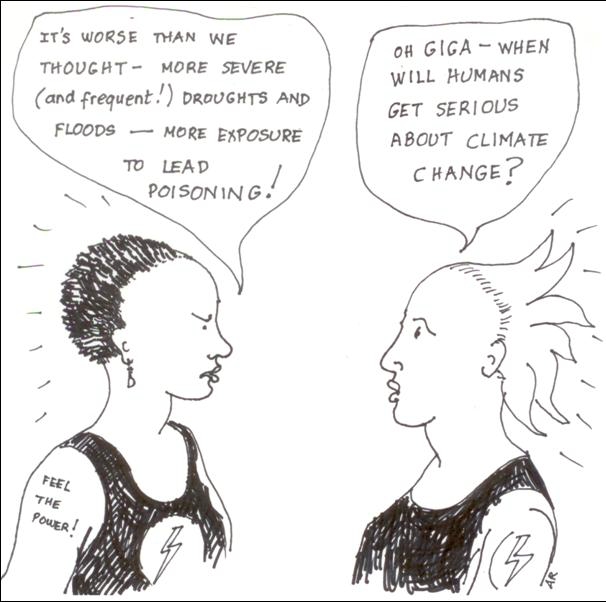 |
|||
| 9 no 4, September, 2009, ISSN 1324-6011 Incorporating Lead Aware Times ( ISSN 1440-4966) and Lead Advisory Service News ( ISSN 1440-0561) The Journal of The LEAD (Lead Education and Abatement Design) Group Inc. Editor-in-Chief: Evan Whitton |
|||
|
About Us
|
What makes climate change and lead poisoning together, worse than either problem on its own? Some fascinating observations (see below) that have been made in many places for many years are that the hotter it is, the higher the blood lead level, and that if someone who already has lead poisoning gets overheated, they suffer worse health effects as a result eg becoming more agitated or aggressive. Drought too, brings dry dusty environments and thirst or restrictions on water use for drinking and especially cleaning away lead pollution – all factors which increase exposure and absorption of lead. One can only wonder at the possible consequences should average temperatures continue to rise and drought affect more of the globe. According to Sir Nicholas Stern, average global temperature has already risen 0.7 degrees centigrade above pre-industrial times. Predictions vary that temperatures will rise another 1.5 – 2 degrees even if action is taken today on reducing greenhouse gases, or 5 – 6 degrees by the end of this century for a “business as usual” scenario. [See http://uktradeinvest.britaus.net/news/newsdefault.asp?id=714 and http://bhc.britaus.net/uploadedFiles/News/Speeches/2007/18]
Drawing by Anne Roberts, 2009 When governments, such as is happening in drought-ridden Australia at the moment, start to apply water restrictions and promote the use of rainwater tanks to capture stormwater or drinking water, they need to also educate the population on the folly of ignorance of lead in roof products or assuming that there is no lead on the water collection area. No one should be allowed to simply add a rain water tank to an existing building without first removing the lead. The Australian Building Code only began to exclude the use of lead flashing on some roof-types in 1996 and many council building officers and builders were not made aware even of that first step towards eliminating obvious sources of lead from roofs. There is such a variety of potential sources of lead that can be found on a roof collection area, it is not in any way an insignificant issue and one tank in four in rural Victoria has higher than the health guideline level of lead in the water as a result. [See “Victorian Tankwater Lead Results Alarming!] Tankwater should always be tested for lead as soon as the tank is installed to ensure that all lead sources were successfully identified and removed. The following list of leaded roof and plumbing products may not even be complete but serves as a guide:
[See “What to do if you have too much lead in your tankwater”] As water becomes more scarce, people will be even more reticent to regularly clean the sludge and lead-headed nails and washers etc out of their tanks, so, lead concentrations can only be expected to rise as temperatures rise. Lead poisoning rates worsened in some drought-affected communities where they were previously showing constant improvement On March 15th 2007, the first rise in blood lead levels since 1992 was reported for young children in Broken Hill – a town in outback Australia and home of the largest lead mining operations in the world. Drought has affected most of central Australia, including Broken Hill where now 28% of young children have a blood lead level exceeding the WHO guideline. Verity Edwards wrote in The Australian newspaper: “The World Health Organisation's guideline for safe blood lead levels is 10 micrograms of lead per decilitre. While the median in Broken Hill has risen from 5.5 µg/dL to 5.9, the Aboriginal mean has risen from 8.7 to 9.7. And lead experts, such as Adelaide University researcher Peter Baghurst, have argued that the WHO levels should be lowered to 2 µg/dL.” [Ref: “Water cost link to high level in kids” www.theaustralian.news.com.au/story/0,20867,21384704-23289,00.html ] |
||
|
About
Us |
bell
system lead poisoning |
Contact Us
| Council
LEAD Project | egroups | Library
- Fact Sheets | Home
Page | Media Releases Newsletters | Q & A | Referral lists | Reports | Site Map | Slide Shows - Films | Subscription | Useful Links | Search this Site |
|||
| Privacy Policy | Disclaimer | |||
|
Last
Updated 19 December 2011
Copyright © The LEAD Group Inc. 1991- 2011 PO Box 161 Summer Hill NSW 2130 Australia Phone: +61 2 9716 0014 |
|||
